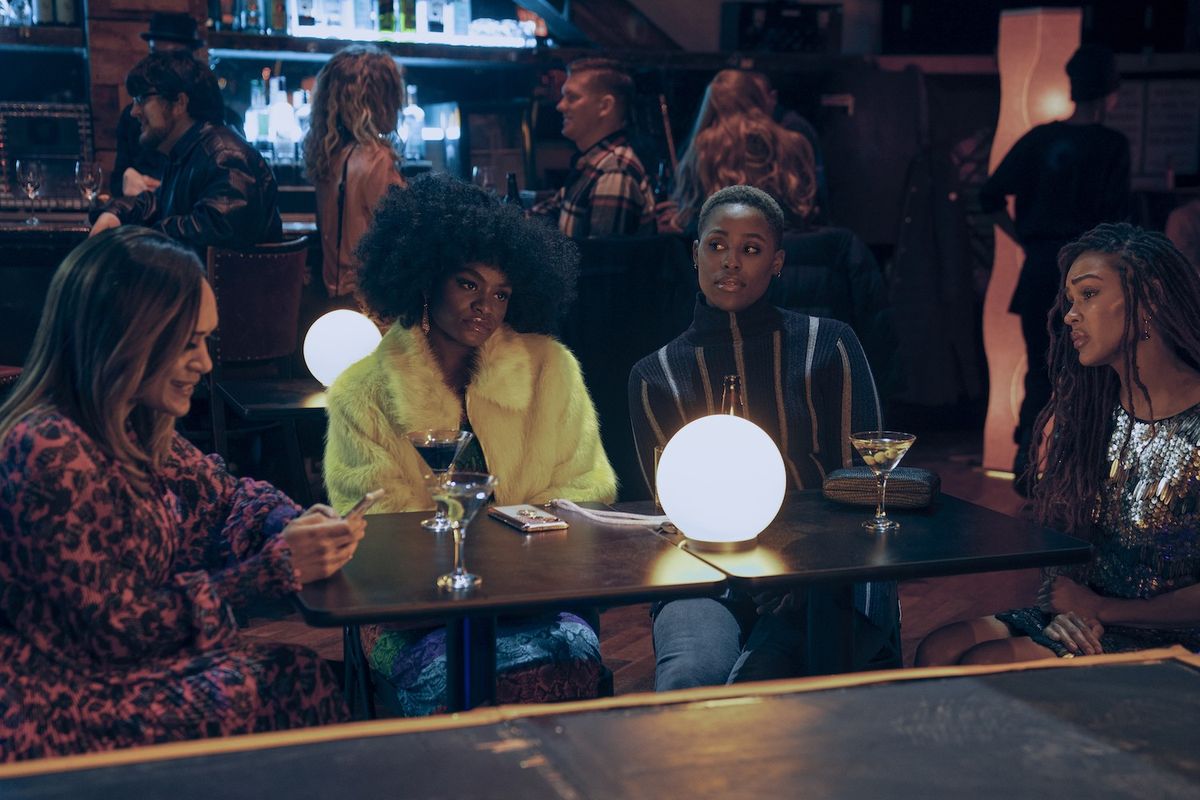
Amazon's Harlem
Harlems revolves around the lives of Black female friends Camille, Angie, Quinn, and Tye. The quartet navigate a changing Harlem in New York. Their lives, too, are changing. Photo Credit: Amazon Prime
To continue reading
Create a free account or sign in to unlock more free articles.
By continuing, you agree to the Terms of Service and acknowledge our Privacy Policy
Register
The content is free, but you must be subscribed to Okayplayer to continue reading.
THANK YOU FOR SUBSCRIBING
Join our newsletter family to stay tapped into the latest in Hip Hop culture!
Login
To continue reading login to your account.
Forgot your password?
Please enter the email address you use for your account so we can send you a link to reset your password:

In the whirlwind that was 2021, Amazon’s Harlem feels cathartic. The glossy comedy series is the latest offering from Girls Trip writer Tracy Oliver. The show, which launched last week (December 3rd), chews through so many sociopolitical issues one could mistake it for a spontaneous babble on Clubhouse. Revolving around the lives of Black female friends Camille, Angie, Quinn, and Tye, the quartet navigate a changing Harlem in New York. Their lives, too, are changing.
On the show, white supremacy is the culprit. Harlem is shapeshifting into a capitalist husk, Black traditions and heritage hollowed out to create a suitable environment for whiteness. Camille (Meagan Good), who is an adjunct professor of anthropology of sex and modern love at Columbia University, makes astute observations on social media about her beloved neighborhood being gentrified. Among the issues Harlem addresses with jabs of humor during its 10 episodes — including microaggressions and cultural appropriation — the most gravitas lands on episode 6, titled “The Strong Black Woman.”
One of the friends in the group, Tye (Jerrie Johnson), has been in pain, clutching her side and wincing. She experiences this in private moments and remains puzzled by what's happening. On a train ride with Quinn (Grace Byers), she grimaces and collapses. Finding herself in the hospital next, she’s flippantly told by the doctor that she’s anemic and needs blood transfusion. When Quinn chimes in with, “What about her back and pelvic pain?” the doctor casually chalks it up to Aunt Flo. But Tye’s period has been going on for more than 10 days. The Tylenol the hospital had administered to her didn’t diminish the pain.
And then things intensifies. “So you are here for drugs,” the doctor says dismissively. Black people and drugs have a long, complicated history in America, and this hospital scene exchange was filtered through that lens. This was flat out medical racism, the doctor refusing to administer opioids to Tye for pain management. Aside from the racial discrimination when it comes to drug access, Tye is already a masculine-presenting lesbian. Along with the “Strong Black Woman” narrative, it becomes a compounding disadvantage.
While this is a fictional experience, it mirrors a visceral reality that Black women endure in the healthcare system. Their strength and capacity are exaggerated, denied utmost care and attention in comparison to white women. This contributes to the high mortality rate amongst Black people, and cuts across socioeconomic status. Even Serena Williams and Beyoncéhave had a brush with stereotyped-fueled, negligent medical practices that put them dangerously at risk. Tracing the coinage of the “Strong Black Woman” trope is nebulous, but it does have roots in European colonialism.
Originally, white people’s assessment of Black people was that their gender was indistinguishable. In their eyes, both Black men and women had traits that weren’t mutually exclusive, meaning possessing features, abilities and aptitudes that overlapped. On the other hand, white people asserted that they could easily differentiate themselves into male and female, which allowed them to arbitrarily construct a superiority over Black people.
With this logic, Black women were subjected to physically debilitating tasks during slavery. This predetermination of strength by the white dominant class was the reason they continued to be exploited for their labor and dehumanized. This opposite is true for white women, seen for their innocence, purity, and femininity. These were the political hallmark of white womanhood. They were the truest, authentic example of what women should embody, possessing a virtue that should be protected. Today, white supremacy still tropes Black women as such, internalized by not only Black women themselves but everyone around them.
In a climate of continued racial discrimination, Black women have adopted the trope as a coping mechanism. The implication of this white supremacist holdover is manifold, ranging from the interpersonal to the institutional. Black women should shoulder a disproportionate amount of responsibilities in intimate and familial spaces, expected to put everyone first at their own detriment. Institutional forces have wrought violence on Black women’s bodies through the police. The medical bias, as illustrated in Tye’s case on Harlem, is another profoundly serious example.
The trope deprives Black women of all the ways they can be human, inhibiting their vulnerability and emotions. And when they attempt to show a different side from their stoic persona, they are labeled “emotional” or “angry” as a tactic to silence them. A couple of hospital scenes later, the entire crew is notified about Tye’s condition. Operated for a ruptured ovarian cyst, a hysterectomy is going to be a drastic procedure needed to stop further growths. Surrounded by Camille, Quinn and Angie (Shoniqua Shondai), this is a breaking point that unleashes the personal difficulties each friend has grappling with.
In that moment, Tye’s hospital bed becomes an emotional shrine, an awakening to the possibilities of feeling humanized than they have been allowed to experience as Black women. In that moment also, it didn’t matter if no one validated them. They validated themselves.
__
Bernard Dayo is a film and fashion critic based in Lagos, Nigeria.